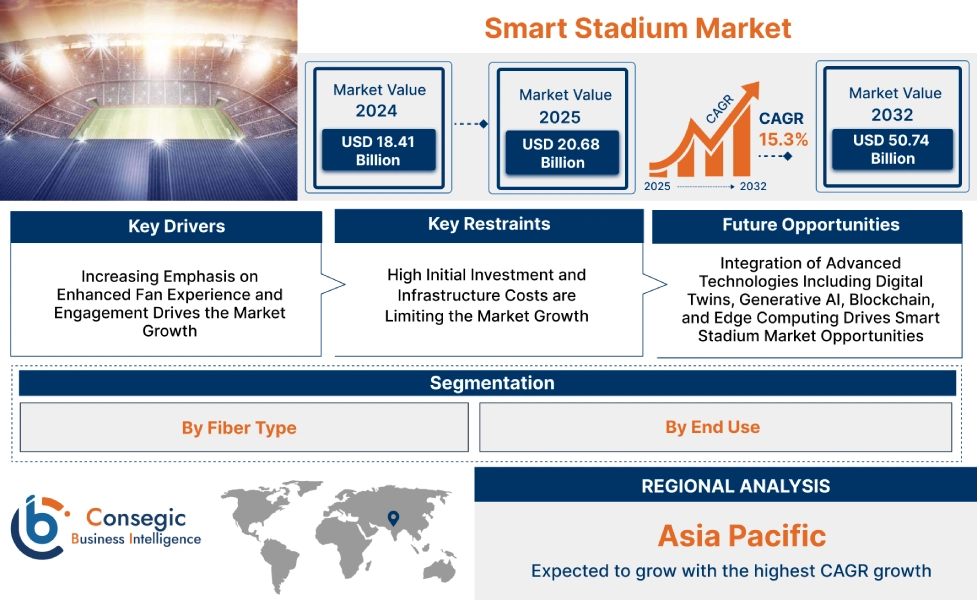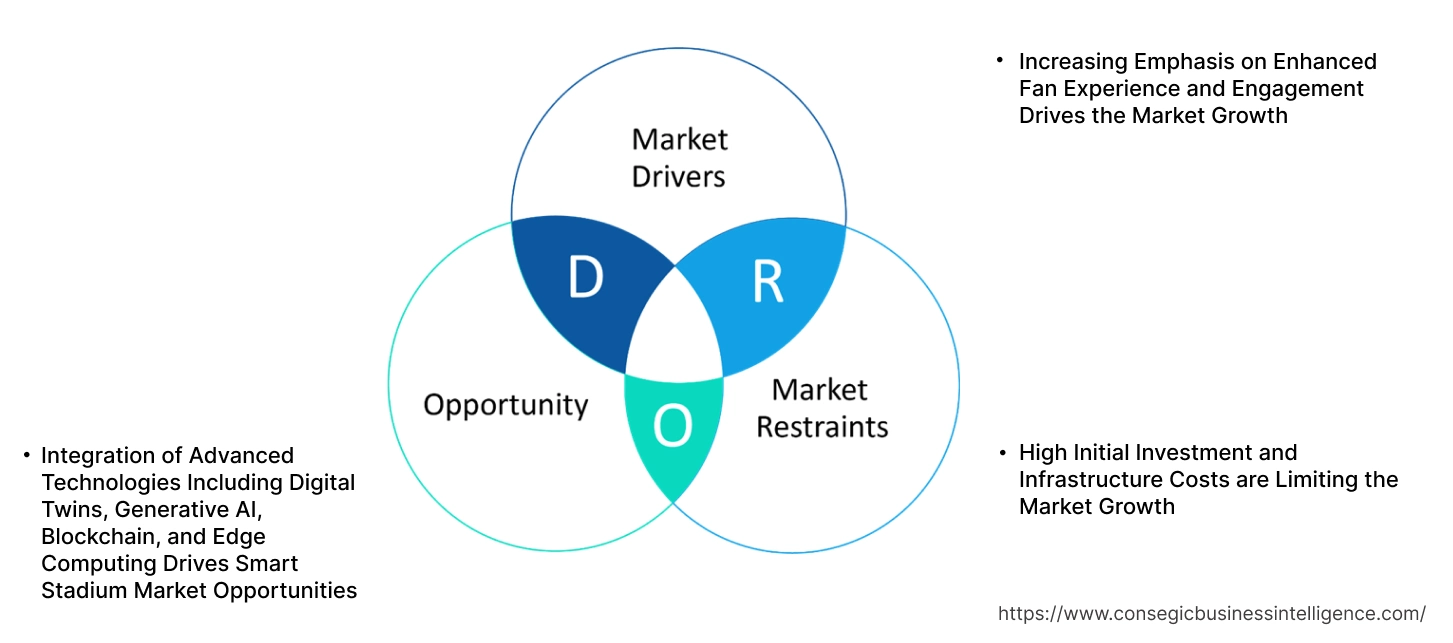Smart Stadium Market Size:
Smart Stadium Market is estimated to reach over USD 50.74 Billion by 2032 from a value of USD 18.41 Billion in 2024 and is projected to grow by USD 20.68 Billion in 2025, growing at a CAGR of 15.3% from 2025 to 2032.
Smart Stadium Market Scope & Overview:
Smart stadium leverages interconnected technologies like IoT sensors, high-speed Wi-Fi, and data analytics to enhance the fan experience, optimize operational efficiency, and ensure safety. These venues offer features such as personalized content, cashless payments, real-time navigation, and predictive maintenance to transform the traditional stadium into a dynamic, data-driven environment which in turn drives the smart stadium market size. Further, the market is driven by trends including increasing emphasis on enhanced fan experience and engagement, and integration of advanced technologies like AI, 5G, and IoT. Additionally, a growing focus on sustainability and increasing investment in sports infrastructure is driving the market.
Smart Stadium Market Dynamics - (DRO) :
Key Drivers:
Increasing Emphasis on Enhanced Fan Experience and Engagement Drives the Market Growth
Smart stadium's rapid growth is significantly propelled by the increasing emphasis on enhancing fan experience and engagement. In present times spectators demand more than just watching a game. They seek immersive, interactive, and personalized experiences. Smart stadiums deliver this through high-density Wi-Fi and 5G, enabling real-time content, AR/VR overlays, and instant replays directly to mobile devices. Further, convenient features like mobile ticketing, in-seat food ordering, and personalized promotions streamline their visit. This elevated experience fosters greater loyalty, encourages repeat attendance, and unlocks new revenue streams via targeted advertising and premium services, directly fueling market expansion and technological adoption.
- For instance, in December 2022, Manchester City Football Club and Cisco announced the deployment of WaitTime, a real-time crowd intelligence technology, at the Etihad Stadium. This makes it the first Premier League venue to utilize this solution. WaitTime, an AI-powered platform, provides real-time data on crowd density, traffic, and movement to enhance guest experience and optimize operational efficiency.
Therefore, enhanced fan experience and engagement driven by high speed internet connectivity, augmented reality (AR) and virtual reality drives the growth of the market.
Key Restraints:
High Initial Investment and Infrastructure Costs are Limiting the Market Growth
The substantial upfront financial outlay for smart stadium implementation remains a key market restraint. Building new smart venues or retrofitting existing ones demands significant investment in advanced hardware such as IoT sensors, 5G infrastructure, digital displays and sophisticated software for everything from security to fan engagement. This capital-intensive nature, coupled with the complexities of integrating diverse systems and an uncertain return on investment, presents a considerable financial burden. Thus, smaller venues or those with limited budgets face significant barriers to adoption, hindering broader market penetration.
Future Opportunities :
Integration of Advanced Technologies Including Digital Twins, Generative AI, Blockchain, and Edge Computing Drives Smart Stadium Market Opportunities
Smart stadium market is significantly boosted by integrating advanced technologies. Digital Twins offer virtual replicas for real-time monitoring, simulation, and predictive maintenance, optimizing operations and fan flow. While generative AI enhances fan engagement through personalized content, dynamic advertising, and immersive AR/VR experiences, creating unique interactions. Further integration of blockchain ensures secure, transparent ticketing and loyalty programs, combating fraud and building trust. Lastly, edge computing processes data locally, enabling ultra-low-latency applications like real-time crowd analytics and instant replays, crucial for immediate decision-making and seamless fan experiences.
- For instance, in February 2023, Fujitsu partnered with EintrachtTech's "Arena of IoT" digital center at Deutsche Bank Park to significantly boost sustainability in stadium management. This collaboration will see Fujitsu implement a sophisticated AI platform that uses machine learning to predict optimal irrigation for green spaces, leading to reduced water consumption.
Thus, these innovations collectively drive new revenue streams and operational efficiencies in turn driving smart stadium market opportunities.
Smart Stadium Market Segmental Analysis :
By Offering:
Based on the offering, the market is segmented into software, hardware, infrastructure, and services.
Trends in the Offering:
- AI-powered software is increasingly used for analyzing fan behavior, optimizing seating arrangements, predicting crowd flow, and personalizing content which in turn drives the smart stadium market trends.
- Increasing use of software solutions incorporating facial recognition, behavioral analysis, and predictive analytics is expected to drive smart stadium market size.
Infrastructure accounted for the largest revenue share of 41.29% in the year 2024.
- Increasing investment in robust network infrastructure, primarily 5G and high-density Wi-Fi, to ensure seamless and high-performance connectivity in turn driving the smart stadium market share.
- Further, there is an increasing deployment of DAS to ensure consistent and strong cellular coverage.
- Furthermore, there is a growing emphasis on integrating smart building automation systems that focus on energy management and sustainable practices which in turn drive the smart stadium market trends.
- For instance, Cisco offers High-Density Wi-Fi, which is revolutionizing stadium experiences by providing seamless, widespread connectivity for every fan, eliminating dead zones through specialized antennas. Further, this powerful network empowers real-time engagement, letting fans instantly share moments and stream content.
- Thus, as per smart stadium market analysis, high-speed connectivity, distributed antenna systems, and sustainable building infrastructure are driving the market.
Services segment is anticipated to register the fastest CAGR during the forecast period.
- There's a high demand for specialized consulting services that help stadium owners and operators plan, design, and strategize their digital transformation
- Further, professional services for deployment and integration ensure that all components work harmoniously and effectively, which in turn drives the smart stadium market growth.
- Furthermore, stadiums are increasingly relying on managed services for continuous monitoring, maintenance, and security which in turn drives smart stadium market demand.
- Thus, based on analysis aforementioned trends are anticipated to drive the smart stadium market growth.
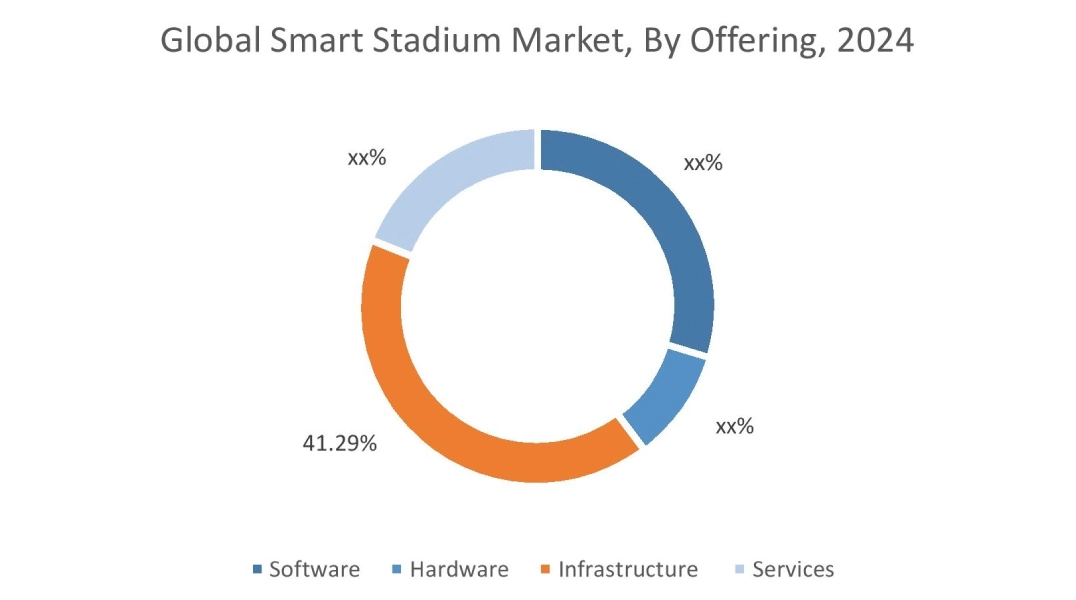
By Installation:
Based on the installation, the market is segmented into new installation and retrofit.
Trends in the Installation:
- Increasing focus on fan satisfaction and operational efficiency drives the smart stadium market demand.
- New installations are often designed with modularity and adaptability, allowing for easy reconfiguration of spaces in turn driving the smart stadium market share.
Retrofit accounted for the largest revenue share in the year 2024.
- Increasing innovation in integrating new smart technologies with existing, older infrastructure and systems is driving the market growth.
- Further, retrofit projects heavily leverage wireless technologies and cloud-based software solutions which in turn drives the smart stadium industry.
- For instance, in October 2023, Cisco officially become the New England Patriots' Technology Partner, deepening a long-standing collaboration. The partnership leverages Cisco's advanced networking solutions, particularly highlighted by the recent Gillette Stadium renovation, to enhance connectivity and security within the prominent NFL venue.
- Thus, as per smart stadium market analysis, integration of new technologies and emphasis on wireless technologies are driving the market.
New installation is anticipated to register the fastest CAGR during the forecast period.
- New installations embed comprehensive 5G networks, high-density Wi-Fi, and robust fiber optics directly into the building's architecture which in turn drives the market.
- Further, new smart stadiums are increasingly incorporating advanced sustainable technologies and designs which in turn propels the smart stadium market expansion.
- Therefore, based on analysis, focus on sustainability and installations of advanced network infrastructure is anticipated to boost the market during the forecast period.
Regional Analysis:
The regions covered are North America, Europe, Asia Pacific, Middle East and Africa, and Latin America.
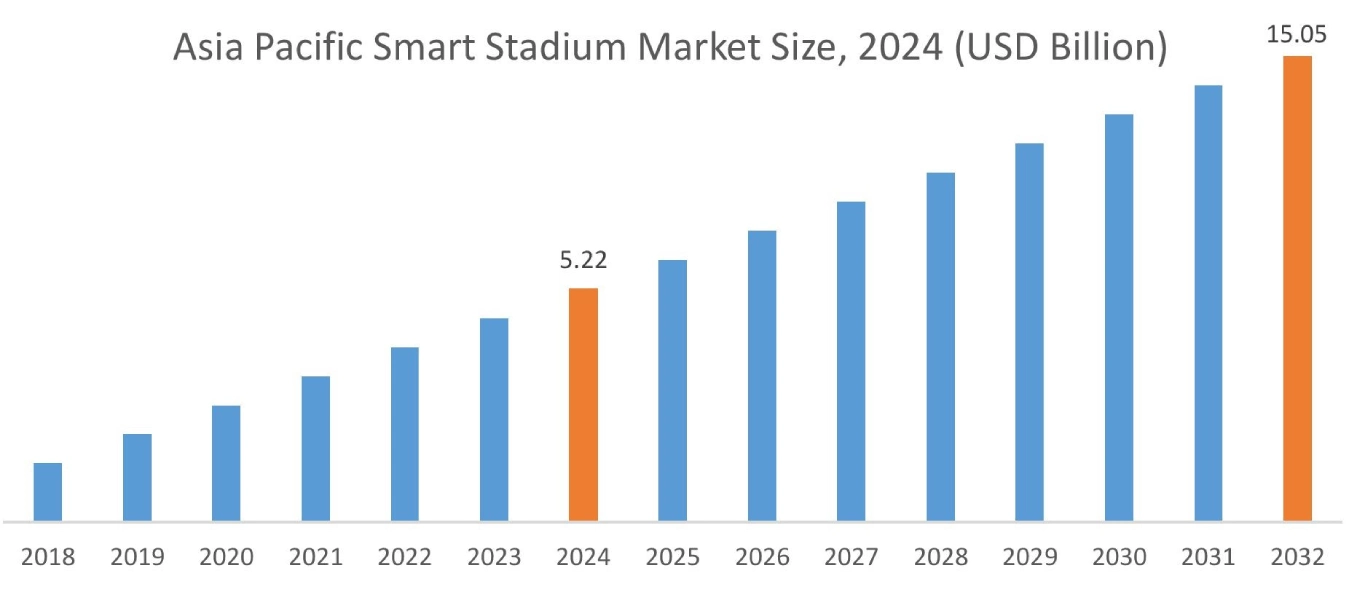
Asia Pacific region was valued at USD 5.22 Billion in 2024. Moreover, it is projected to grow by USD 5.89 Billion in 2025 and reach over USD 15.05 Billion by 2032. Out of this, China accounted for the maximum revenue share of 26.51%. The market for smart stadiums is mainly driven by increasing trend of digitalization of sports and significant investments in new sports infrastructure.
- For instance, in October 2024, Huawei launched its new Intelligent Stadium Solution. This solution aims to drive the digital and intelligent transformation of stadium campuses. Huawei used the platform to discuss with industry leaders how AI and other digital technologies can unlock new opportunities and guide future industry development.
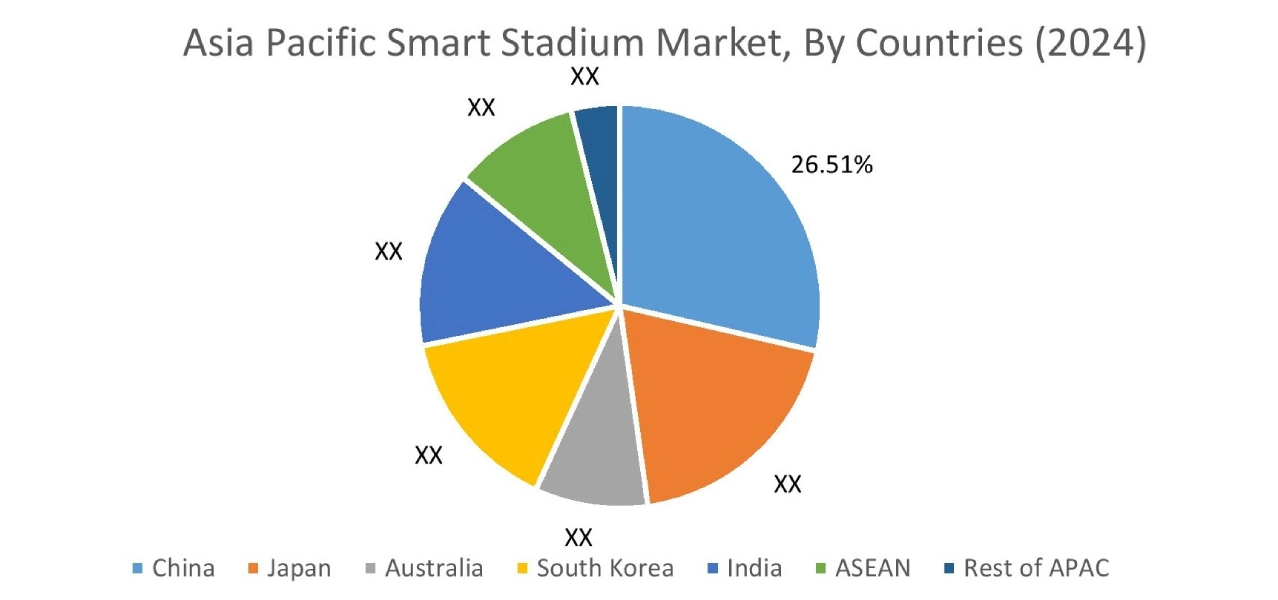
North America is estimated to reach over USD 16.54 Billion by 2032 from a value of USD 5.99 Billion in 2024 and is projected to grow by USD 6.73 Billion in 2025. The North American market is primarily driven by increasing demand for enhanced fan experiences, need for greater operational efficiency and safety, and rapid integration of advanced technologies.
- For instance, in September 2024, HYPE Sports Innovation and IBM partnered to accelerate AI innovation in sports, providing sports tech startups with access to IBM watsonx, IBM's advanced AI and data platform. This collaboration empowers startups to develop and scale AI-driven solutions for various applications, including player analytics, team strategy optimization, smart stadium management, and personalized fan experiences.
Regional analysis depicts strong sports culture, stringent public safety regulations, increasing focus on enhancing fan experiences in Europe is driving the smart stadium market expansion. Additionally, factors driving the market in the Middle East and African region are significant government investments in developing world-class sports infrastructure, and a strong focus on enhancing fan experiences. Further, deep-rooted passion for sports, especially football, coupled with increasing investments in modernizing existing sports infrastructure and building new venues is paving the way for the progress of market trends in Latin America region.
Top Key Players and Market Share Insights:
The global smart stadium market is highly competitive with major players providing solutions to the national and international markets. Key players are adopting several strategies in research and development (R&D), product innovation, and end-user launches to hold a strong position in the smart stadium industry. Key players in the global smart stadium market include-
- Cisco Systems Inc. (U.S.)
- NXP Semiconductors NV (Netherlands)
- Schneider Electric SE (France)
- Telefonaktiebolaget LM Ericsson (Sweden)
- GP Smart Stadium (Netherlands)
- IBM Corporation (U.S.)
- NEC Corporation (Japan)
- Johnson Controls Inc (Ireland)
- Huawei Technologies Co Ltd (China)
- Intel Corporation (U.S.)
Recent Industry Developments :
Partnership and Collaboration
In June 2025, All England Lawn Tennis Club and IBM introduced new AI-powered digital features for Wimbledon 2025, leveraging generative AI on watsonx and match data. A new interactive AI assistant called 'Match Chat' will answer fan questions during live singles matches. Additionally, the 'Likelihood to Win' tool will be enhanced to provide dynamic win percentages that update throughout each game.
Smart Stadium Market Report Insights :
| Report Attributes | Report Details |
| Study Timeline | 2019-2032 |
| Market Size in 2032 | USD 50.74 Billion |
| CAGR (2025-2032) | 15.3% |
| By Offering |
|
| By Installation |
|
| By Region |
|
| Key Players |
|
| North America | U.S. Canada Mexico |
| Europe | U.K. Germany France Spain Italy Russia Benelux Rest of Europe |
| APAC | China South Korea Japan India Australia ASEAN Rest of Asia-Pacific |
| Middle East and Africa | GCC Turkey South Africa Rest of MEA |
| LATAM | Brazil Argentina Chile Rest of LATAM |
| Report Coverage |
|
Key Questions Answered in the Report
How big is the smart stadium market? +
The smart stadium market is estimated to reach over USD 50.74 Billion by 2032 from a value of USD 18.41 Billion in 2024 and is projected to grow by USD 20.68 Billion in 2025, growing at a CAGR of 15.3% from 2025 to 2032.
What specific segmentation details are covered in the smart stadium report? +
The smart stadium report includes specific segmentation details for offering, installation, and regions.
Which is the fastest segment anticipated to impact the market growth? +
In the smart stadium market, new installation is the fastest-growing segment during the forecast period.
Who are the major players in the smart stadium market? +
The key participants in the smart stadium market are Cisco Systems Inc. (U.S.), IBM Corporation (U.S.), NEC Corporation (Japan), Johnson Controls Inc (Ireland), Huawei Technologies Co Ltd (China), Intel Corporation (U.S.), NXP Semiconductors NV (Netherlands), Schneider Electric SE (France), Telefonaktiebolaget LM Ericsson (Sweden), GP Smart Stadium (Netherlands) and others.
What are the key trends in the smart stadium market? +
The smart stadium market is shaped by several key trends including increasing emphasis on enhanced fan experience and engagement, integration of advanced technologies like AI, 5G, and IoT, and a growing focus on sustainability.
